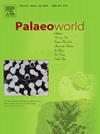Oldest hippopotamus record (Hippopotamus antiquus) from Anatolia (Datça Peninsula, Southwest Türkiye)
IF 1.7
3区 地球科学
Q2 PALEONTOLOGY
引用次数: 0
Abstract
Taxonomy and chronology of the Eurasian fossil hippopotamuses have been under debate, particularly regarding fossil records from Southwest and Central Europe. The genus Hippopotamus is recognized as a highly successful group that, during the Pleistocene, expanded its range from Western Europe through Anatolia, encompassing the entire Middle East and the eastern and northern shores of Africa, being designated as the “Hippo event”. However, despite this extensive expansion, detailed analysis of paleontological records from these regions reveals that Anatolia, which served as a suitable land bridge between Europe, Asia, and Africa, contains a relatively limited number of Hippopotamus records. Therefore, the scarcity of records in Anatolia presents a paradox in paleobiogeographic studies.
This research is the first paleontological study in Türkiye to describe a Hippopotamus antiquus specimen from the lower Pleistocene, providing new insights into the taxonomy, systematics, and biogeography of Anatolian hippos. The specimen described here was discovered in the Reşadiye, Datça region (Southwest Anatolia) during the early 1980s. The specimen exhibits definitive diagnostic characteristics of H. antiquus, representing the first and earliest record of this species in Anatolia. The temporal and spatial correlations of the Datça specimens with contemporaneous taxa from Europe, Africa, and other parts of Anatolia (e.g., Burdur-Kocakır-2, Karain Cave, Konya-Dursunlu) highlight the geographical and chronological continuity of European hippos during the Quaternary. This study provides new data and insights into the evolution and dispersal patterns of these large semi-aquatic mammals.
最古老的河马记录(hippopotamus antiquus)来自安纳托利亚(dat半岛西南部)
欧亚河马化石的分类学和年代学一直存在争议,特别是关于西南和中欧的化石记录。河马属被认为是一个非常成功的群体,在更新世期间,它将其范围从西欧扩展到安纳托利亚,包括整个中东和非洲东部和北部海岸,被指定为“河马事件”。然而,尽管有如此广泛的扩展,但对这些地区古生物记录的详细分析表明,安纳托利亚作为欧洲、亚洲和非洲之间合适的陆桥,包含的河马记录数量相对有限。因此,安纳托利亚记录的缺乏成为古生物地理研究中的一个悖论。本研究是我国首次对下更新世的河马标本进行古生物学研究,为安纳托利亚河马的分类学、系统学和生物地理学提供了新的见解。这里描述的标本是在20世纪80年代初在readiye, data地区(安纳托利亚西南部)发现的。该标本显示了古猿人的明确诊断特征,代表了该物种在安纳托利亚的最早记录。data标本与欧洲、非洲和安纳托利亚其他地区(如Burdur-Kocakır-2、Karain Cave、Konya-Dursunlu)同期分类群的时空相关性突出了第四纪欧洲河马的地理和时间连续性。这项研究为这些大型半水生哺乳动物的进化和扩散模式提供了新的数据和见解。
本文章由计算机程序翻译,如有差异,请以英文原文为准。
求助全文
约1分钟内获得全文
求助全文
来源期刊

Palaeoworld
PALEONTOLOGY-
CiteScore
4.00
自引率
5.90%
发文量
95
期刊介绍:
Palaeoworld is a peer-reviewed quarterly journal dedicated to the study of past life and its environment. We encourage submission of original manuscripts on all aspects of palaeontology and stratigraphy, comparisons of regional and global data in time and space, and results generated by interdisciplinary investigations in related fields. Some issues will be devoted entirely to a special theme whereas others will be composed of contributed articles. Palaeoworld is dedicated to serving a broad spectrum of geoscientists and palaeobiologists as well as serving as a resource for students in fields as diverse as palaeobiology, evolutionary biology, taxonomy and phylogeny, geobiology, historical geology, and palaeoenvironment.
Palaeoworld publishes original articles in the following areas:
•Phylogeny and taxonomic studies of all fossil groups
•Biostratigraphy, chemostratigraphy, chronostratigraphy
•Palaeoecology, palaeoenvironment and global changes throughout Earth history
•Tempo and mode of biological evolution
•Biological events in Earth history (e.g., extinctions, radiations)
•Ecosystem evolution
•Geobiology and molecular palaeobiology
•Palaeontological and stratigraphic methods
•Interdisciplinary studies focusing on fossils and strata
 求助内容:
求助内容: 应助结果提醒方式:
应助结果提醒方式:


